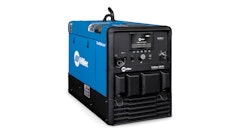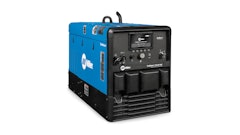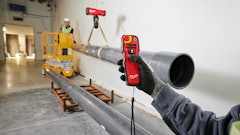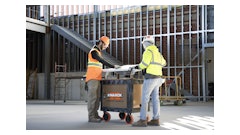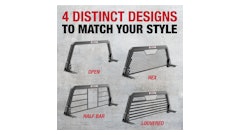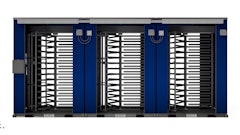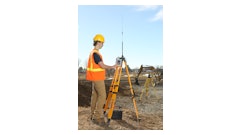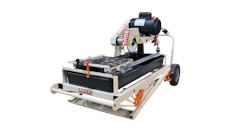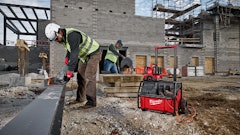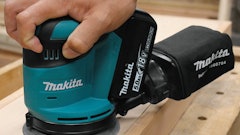
Achieving optimum efficiency from an air compressor requires properly sizing it to the application. This calls for at least a basic understanding of the variables involved.
“There are two variances contractors should be aware of to properly size their compressor: the flow of the compressor in cubic feet per minute (cfm) and the discharge pressure in pounds per square inch (psi). These two metrics (cfm and psi) are inversely related — when one is higher, the other is lower — and it is important to understand that relationship to size a compressor for optimum efficiency,” says Ryan Youngblood, oil and gas sales manager, Atlas Copco Construction Equipment.
“Undersizing a compressor means wasted time waiting for enough air to be generated,” he points out. “Undersizing will also result in tool inefficiency, as the tool won’t receive the correct pressure to perform properly.”
“If you oversize a compressor, you are wasting fuel,” adds Michael Camber, marketing services manager, Kaeser Compressors Inc. “It takes more energy to compress air at a higher pressure. If the tool you are using doesn’t require that higher pressure, you are wasting energy/fuel and potentially harming the tool.”
Determine cfm requirements
A compressor is typically sized according to the amount of air it can compress to 100 psi in one minute, says Camber. This is denoted in cfm, which is also referred to as flow or volume.
The first step in sizing a compressor is to establish the cfm requirements of the tools. “Contractors know the tools they need to get the job done,” says Juan Rubio, assistant product manager – Small Air Compressors, Doosan Portable Power. “Whether it’s a rivet buster, chipping hammer or a paving breaker, a contractor should also know the ratings for those tools. The amount of air required is driven by the tools being utilized.”
Rating information is typically labeled directly on the tool, or can be found in the owner’s manual. As a rule of thumb, a paving breaker’s weight usually corresponds to the amount of cfm it requires. For example, a 90-lb. breaker requires approximately 90 cfm; a 60-lb. breaker requires approximately 60 cfm, etc.
It is also important to know if you will need to run more than one tool and if they will need to run simultaneously. Many compressors have several outlets to power multiple tools. “If you plan to run several tools at the same time, you simply need to add up the flow of the tools and make sure the compressor outputs that flow (cfm),” says Camber.
For example, he notes that one of the most common sizes of compressors is 185 cfm. With this unit, you could efficiently operate two 90-lb. breakers simultaneously (90 cfm + 90 cfm = 180 cfm) or three 60-lb. breakers (60 cfm + 60 cfm + 60 cfm = 180 cfm).
However, it’s important to take into account the altitude at which the compressor will be operated. “The air is thinner at higher elevations and, as a consequence, the reduced air pressure affects how the engine runs and how much air pressure is produced,” says Youngblood.
“The higher the elevation, the more the unit will need to be oversized for the same application,” confirms Camber. “Ambient air pressure is reduced by one-half psi for every 1,000 ft. in elevation.”
Pressure considerations
Pressure levels for tools are set by the manufacturer at the factory (typically 90 psi). Many tool manufacturers make an effort to size their tools to be easily interchangeable at a site. To avoid damaging the tool, don’t exceed these levels.
“A tool is designed to operate at a certain pressure with a certain volume,” says Camber. “It’s a common thought process that if a tool is not being fed enough air, it’s not getting enough pressure [psi]. However, in reality, it’s most likely not receiving enough volume [cfm] because the compressor is undersized. This results in a drop in pressure.”
“It’s very important to use the right pressure for each tool,” says Rubio. “Tools are rated differently, and while many pneumatic tools are rated at 90 psi, using more pressure than what the tool is rated for can damage the tool and potentially be a safety issue.”
Some tools, such as sand blasting equipment, may have psi levels above 150 psi. “Sandblasting is a heavy air use application and the higher psi propels the media faster,” Camber points out. Special consideration should be given to the nozzle in this application, as the size of the nozzle affects the amount of air required.
“When purchasing or renting a compressor, be sure to ask questions,” advises Youngblood. “Manufacturers, dealers and rental stores have the proper resources and information to determine the appropriate size compressor for your application.”
Minimize Pressure Loss
The size and length of hose can also impact air compressor performance.
“How far away the compressor will be from where the air is being used is a good question to ask,” says Youngblood. “There will be pressure drop in the hose used to transport the compressed air and the user may not get what they were expecting at the point of use.”
“There will be pressure loss regardless of application due to fittings, hoses, elbows and connections,” says Rubio. Hoses are rated in 50-ft. increments, and for 180 cfm at 100 psi, pressure loss would be approximately 3.8 psi, he explains.
Hose size is critical. “The hose on a 375-cfm unit needs to be bigger than the hose on a 185-cfm unit to handle double the volume (cfm),” says Camber. “If the hose is too narrow, it causes pressure restriction. Even though the compressor is trying to pump out a certain amount of air, the hose will be too narrow and pressure loss will result.”
”It's not only important to know the rating of the tools, and the size and length of the hose connected to the air compressor, but attention also needs to be given to pressure loss and how to compensate for it,” says Rubio.













